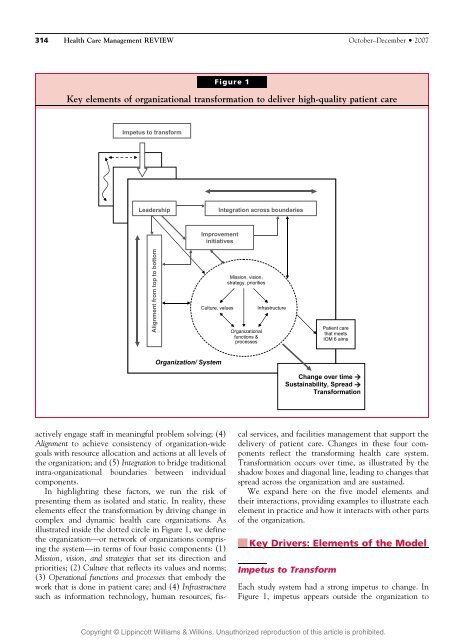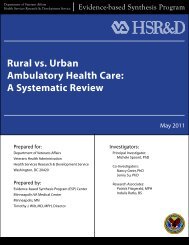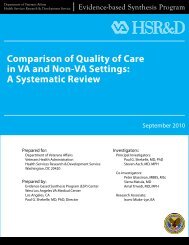VHA Systems Redesign; Transformational change in health care ...
VHA Systems Redesign; Transformational change in health care ...
VHA Systems Redesign; Transformational change in health care ...
Create successful ePaper yourself
Turn your PDF publications into a flip-book with our unique Google optimized e-Paper software.
314 Health Care Management REVIEW<br />
October–December 2007<br />
Figure 1<br />
Key elements of organizational transformation to deliver high-quality patient <strong>care</strong><br />
actively engage staff <strong>in</strong> mean<strong>in</strong>gful problem solv<strong>in</strong>g; (4)<br />
Alignment to achieve consistency of organization-wide<br />
goals with resource allocation and actions at all levels of<br />
the organization; and (5) Integration to bridge traditional<br />
<strong>in</strong>tra-organizational boundaries between <strong>in</strong>dividual<br />
components.<br />
In highlight<strong>in</strong>g these factors, we run the risk of<br />
present<strong>in</strong>g them as isolated and static. In reality, these<br />
elements effect the transformation by driv<strong>in</strong>g <strong>change</strong> <strong>in</strong><br />
complex and dynamic <strong>health</strong> <strong>care</strong> organizations. As<br />
illustrated <strong>in</strong>side the dotted circle <strong>in</strong> Figure 1, we def<strong>in</strong>e<br />
the organization—or network of organizations compris<strong>in</strong>g<br />
the system—<strong>in</strong> terms of four basic components: (1)<br />
Mission, vision, and strategies that set its direction and<br />
priorities; (2) Culture that reflects its values and norms;<br />
(3) Operational functions and processes that embody the<br />
work that is done <strong>in</strong> patient <strong>care</strong>; and (4) Infrastructure<br />
such as <strong>in</strong>formation technology, human resources, fiscal<br />
services, and facilities management that support the<br />
delivery of patient <strong>care</strong>. Changes <strong>in</strong> these four components<br />
reflect the transform<strong>in</strong>g <strong>health</strong> <strong>care</strong> system.<br />
Transformation occurs over time, as illustrated by the<br />
shadow boxes and diagonal l<strong>in</strong>e, lead<strong>in</strong>g to <strong>change</strong>s that<br />
spread across the organization and are susta<strong>in</strong>ed.<br />
We expand here on the five model elements and<br />
their <strong>in</strong>teractions, provid<strong>in</strong>g examples to illustrate each<br />
element <strong>in</strong> practice and how it <strong>in</strong>teracts with other parts<br />
of the organization.<br />
Key Drivers: Elements of the Model<br />
Impetus to Transform<br />
Each study system had a strong impetus to <strong>change</strong>. In<br />
Figure 1, impetus appears outside the organization to<br />
Copyright @ Lipp<strong>in</strong>cott Williams & Wilk<strong>in</strong>s. Unauthorized reproduction of this article is prohibited.

















